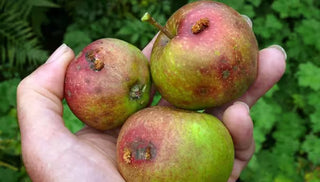One of the major pests on apples, the codling moth, is found in all areas where apples are grown. It attacks pears, apricots and quinces as well as apples. Small holes are found on the fruit, usually at or near the blossom end. Inside, pinkish-white worms with brown heads feed on the flesh, leaving tunnels full of sawdustlike frass (droppings). The feeding larvae inside the developing fruit often causes fruits to drop prematurely.
The codling moth larvae overwinter in cocoons under loose bark on the trunk or under debris on the ground. In midspring they pupate, emerging as grayish-brown moths in late spring. The females lay eggs on leaves, twigs and fruits. The larvae feed briefly on the leaves before tunneling into the fruits. After feeding for three to five weeks, they emerge and crawl down the trunk in search of a spot to pupate. There may be up to three generations per year.
Controls
- Spray with the insecticide Bacillus thuringiensis (Bt). At least three sprayings are needed, and timing is critical: Make the first spray 15 days after petal fall begins, and subsequently at five-day intervals. Note when petal fall begins and mark the spray days on a calendar. Orchardists use sticky traps baited with codling moth pheromone in order to time sprays exactly.
- Parasitic wasps are available to attack the caterpillars as they hatch.
- Rake leaves and dropped fruit through the growing season and in autumn after all leaves have fallen.




